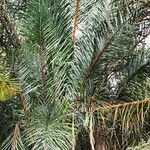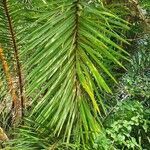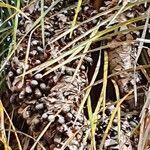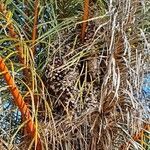Massive, clustering (rarely solitary) palm to 25 m. or more tall; trunk to 60 cm. or more in diameter, to 10 m. tall or more, the lower part with pronounced leaf-scars, some remains of rotted leaf-sheaths and apogeotropic adventitious roots, upper part covered with leaf-bases.. Leaves erect, slightly spreading, giving most crowns a rather characteristic ‘shuttlecock’ appearance, very large, to 20 m. long; leaf-base sheathing at the base, with a ragged ligular edge; petiole rounded, to 1.5 m. long, ± 20 cm. in diameter, decreasing gradually, ±12 cm. in diameter at the insertion of the lowermost leaflets, and the rachis gradually decreasing above; rachis in fresh state orangey brown or almost crimson, with 2 lateral grooves near the base, accommodating the leaflets in bud and a median adaxial crest distally; leaflets up to ± 150 or more on each side, to 1 m. long by 8 cm. wide, inserted mostly in two planes, the whole leaf hence appearing plumose, stiff, hardly drooping; margins and main veins with distally pointing spines to 3 mm. long; lamina abaxially white waxy, very sparsely waxy adaxially; main veins usually somewhat reddish in colour.. Inflorescences produced ± simultaneously from the axils of reduced leaves at the stem apex, pendulous, massive, to 3 m. long by 35 cm. wide. Primary inflorescence-bracts to 30 cm. long by 20 cm. wide, tubular, partially enclosing the first and second order branches; primary branching system to 30 cm. long and 2.5 cm. wide at the base with a basal 2-keeled prophyll to 18 cm. long; and 1 or a few empty tubular bracts to 6 cm. long; further bracts ± 5 mm. apart, closely sheathing, ± 4-ranked, each subtending a rachilla; all rachillae lying close together and almost congested at anthesis; rachillae to 12 cm. in proximal part of inflorescence, shorter in distal part, exceptionally to 15 cm., to 1.5 cm. wide.. Male flower to 12 mm. long by 2 mm. wide, enclosed by a 2-keeled prophyll to 6 mm. long; calyx tubular, scarcely 3-lobed, to 4 mm. long; corolla with a basal tube to 2 mm. long and 3 lobes 10 mm. long by 1.5 mm. wide, acute, slightly thickened in the uppermost 3 mm.; stamens 6, epipetalous at the mouth of the corolla-tube, with filaments 2 mm. long by 0.5 mm. wide, fleshy and weakly connate, anthers ± 3.5 mm. long by 0.5 mm. wide; pistillode not seen.. Pistillate flower enclosed in a 2-keeled prophyll to 8 mm. long and a second bracteole to 3 mm. long; calyx tubular, truncate, usually splitting, to 8 mm. by 4 mm.; corolla much shorter than the calyx, hence hidden, tubular in the proximal 2 mm., with poorly developed apiculate lobes to 3 mm. long by 2 mm. wide; staminodes 6, very inconspicuous; ovary to 5 mm. long by 3 mm. wide, covered in vertical rows of reflexed orangey brown fimbriate scales.. Fruit at maturity very variable, ovoid, pyriform, or ellipsoidal, sometimes developing without seed, in which case very narrowly ellipsoidal, 7.5–10 × 4–5.5 cm., covered in 12–13 rows of convex reflexed scales and tipped by a short beak to 5 mm. high; scales normally with a pronounced mid-groove and a deep dimple at the base into which fits the tip of the next scale, the largest scales ± 15 mm. long, 18 mm. wide, bright orangey brown in colour; mesocarp to ± 5 mm. thick when fresh, oily, drying very hard.. Seed usually 1 only, 4–6 cm. long by 3–4 cm. in diameter, its shape conforming to the external shape of the fruit, pointed at the base; sarcotesta closely grooved in dry specimens; endosperm with sparse ruminations.. Fig. 7.
More
A palm with a single trunk. The trunk is usually very short. The fronds grow to 8-10 m high. There are new suckers produced at the base. The leaves are 15-18 m long. They hang over. They are feather-like and 18 m long. The male and female flowers are separate on a large branched plume like structure. This can be 3 m long and take 2-3 years to develop. The flower head starts erect and later bends over and hangs below the leaves. The fruit are oblong and 9 cm long. They have overlapping scales. They are shiny and brown and have one seed inside.






